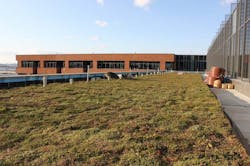U.S. Coast Guard Headquarters - vegetative roof assembly, Washington, D.C.
Driven by Federally-mandated sustainable requirements, a 300,000 plus square-foot Vegetative Roof Assembly (VRA) was incorporated into the architectural design for the U.S. Coast Guard’s 11-level, 1.2 million square foot headquarters located in Washington D.C.
Since the U.S. Coast Guard Headquarters structure is terraced into the hillside with elevation changes of 120 feet, two levels were above-ground while the remaining nine were built into the hillside. As a result, the VRA architectural design and construction team navigated a range of unique design considerations to ultimately receive LEED Gold certification from the U.S. Green Building Council.
A cross-functional team collaborated throughout the three-phased VRA construction. Under the direction of WDG Architecture, the architect of record for the roofing, and HOK, the lead on vegetative roof components, Gordon Contracting served as the roofing contractor and Tilson Group supplied and installed the hundreds of thousands of individual vegetative roof plants.
From the outset of the project, the integrated roofing team was tasked with designing a VRA that would help decrease the building’s heating and cooling energy usage, reduce and filter storm water runoff, lower long-term maintenance and extend the life of the roof. The unique roof would also serve to integrate the 176-acre campus with the building and its 4,000 occupants.
To accomplish these objectives, the project team carefully selected performance-based product solutions that would work in conjunction to support the roof vegetation. FOAMULAR® 404 & 604 extruded polystyrene (XPS) insulations were selected for use in Protected Roof Membrane Assemblies (PRMA), where the insulation is placed directly over the membrane.
The water resistance and compressive strength of FOAMULAR® XPS insulation provided the integrity needed for long-term roof performance at this building site. The product composition also helped contribute towards attaining LEED Gold certification.
Given the sheer scope and size of the VRA project, it was inevitable that the roofing team would encounter several scenarios that required strategic problem-solving throughout the VRA installation. For example, the team adjusted the engineered soil specification to reduce the loads within the structural tolerances for the roof structure and carefully addressed a range of pH, moisture, organic matter and nutrient levels to support the variety of plants.
In addition to managing a range of prescribed planting installation seasons, the heat during the Washington, D.C. summers also added complexity and the need to ensure the plants receive sufficient water during their establishment period.
After successfully navigating a wide range of challenges and opportunities, the U.S. Coast Guard Headquarters’ VRA epitomizes the marriage of form and function and is recognized among the largest green roofs in the world.
Completed in 2013, the VRA not only aesthetically enhances the building, but it also retains storm water that would otherwise combine with waste water that may bypass the Blue Plains Wastewater plant. In fact, according to the Landscape Performance Foundation, the headquarters’ vegetative roof retains up to 424,000 gallons of rainwater.
For more information, please visit www.owenscorning.com or call 1-800-GET-PINK.

